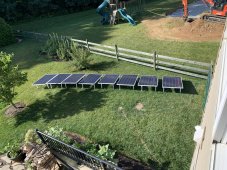eabyrd
Solar Enthusiast
i have 8 identical panels. 250 watt. 37VOC. 30VMP. 8AMP (fractions truncated) currently running into a Victron Smartsolar 150/35 to charge a Bigbattery HSKY and run a Sigineer split phase 6kw inverter charger currently the panels are in a 4s2p configuration and max out at a bit over 1850 watts. Total production if I stay out of absorption or float is about 12k best I can tell.
i am strongly considering buying a MPP LVX 6048 which, among other improvements (intended for home use being primary) would allow me to run the string as an 8s1p configuration. I am not sure if I will be better able to limit the wasted capacity that comes with a full battery
There is partial shading in early to mid AM over 3 or 4 of the panels. The total wire run through 10 gauge is less than 100 feet so I don’t think those losses are significant, but I could be wrong
would you think my peak power /overall production would go up, down, or remain essentially the same in the new configuration
looking forward to thoughts and perspectives
ed
i am strongly considering buying a MPP LVX 6048 which, among other improvements (intended for home use being primary) would allow me to run the string as an 8s1p configuration. I am not sure if I will be better able to limit the wasted capacity that comes with a full battery
There is partial shading in early to mid AM over 3 or 4 of the panels. The total wire run through 10 gauge is less than 100 feet so I don’t think those losses are significant, but I could be wrong
would you think my peak power /overall production would go up, down, or remain essentially the same in the new configuration
looking forward to thoughts and perspectives
ed



